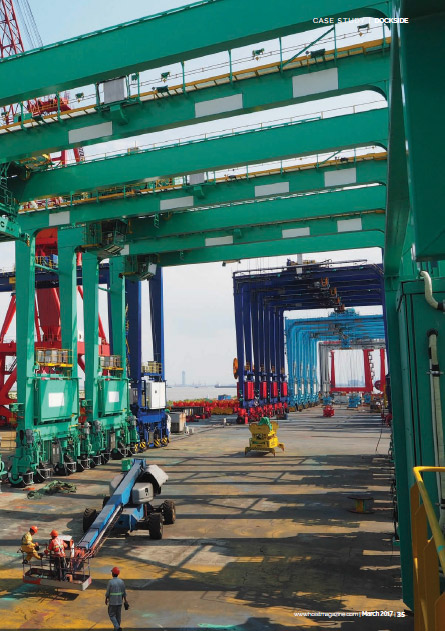Fuel Savers
21 March 2017Corvus Energy and integrators CCCC Shanghai Equipment Engineering have worked together to retrofit a number of diesel RTGs into hybrid diesel and LNG-battery cranes
Hybridising RTGs, says Corvus, can reduce fuel consumption by 65%, reducing operating costs. It also lowers exhaust and noise emissions at the container terminals and storage yards where RTGs are most commonly used.
The process involved installing an industrial-quality Energy Storage System (ESS) onto each crane. The lithium-ion system is a smaller, ultra high-power, liquid-cooled technology that was designed to meet the specific power requirements of the RTG cranes manufactured by CCCC Shanghai Equipment Engineering (CCCCSEE), says Corvus.
The first order for the hybridised cranes has come from Shanghai International Port Group, with the cranes due to be installed in Yidong Terminal, Shanghai.
Sean Puchalski, vice president strategic marketing at Corvus Energy, says: “This latest order from CCCCSEE for the Yidong Port once again proves the viability of energy storage for the hybridization of industrial equipment such as port equipment.
“Our customers challenged us to come up with a product with even greater power density, allowing them to support aggressive load profiles with a smaller footprint and cost. Corvus technology continues to be the answer for progressive port operators worldwide, who seek to increase efficiencies while reducing emissions and the environmental impact of their operations.”
Gao Jianzhong, chief engineer at CCCCSEE, added: “CCCCSEE’s continued commitment to the development and implementation of advanced technology solutions for port operations supports our corporate vision to be industry leaders through engineering excellence.
“Corvus technology is a cornerstone of this strategy and the proven performance, durability and reliability of its battery systems is ideally suited to the demands of our industrial applications.”
Saving Power
The ESS provides a range of benefits, including regenerative braking, where braking energy is captured and stored as electricity when a container is lowered. This energy is directed to the ESS to be re-used.
Idling is eliminated compared to conventional RTGs, where the diesel generator will typically undergo periods of sustained idling, using up fuel. Using the ESS, the cranes can shut down during these periods, allowing the RTG to operate on fully-electric battery power.
The battery also allows the generator to be sized for the average load, with the battery handling peak power output requirements. By reducing a 500kW generator down to a 50kW version, both fuel consumption and exhaust emissions are reduced.
At the Port of Shanghai opertions, where around 204 RTGs are in operation across three terminals, Corvus calculates that converting all the cranes to hybrid RTGs would save just under 20m litres of fuel a year, on an original total of just over 30m l. RTG cranes create a disproportionately high amount of air pollutants and emissions, says Corvus, emitting around 11% of oxides of nitrogen emissions, and 9% of diesel particulate matter produced from cargo handling equipment at ports.
